Permeation of AuCl4− Across a Liquid Membrane Impregnated with A324H+Cl− Ionic Liquid
Abstract
1. Introduction
2. Materials and Methods
3. Results
3.1. Liquid-Liquid Extraction
3.2. Supported Liquid Membrane Transport
3.2.1. Influence of the Stirring Speed
3.2.2. Effect of Receiving Phase Composition on Permeability of Gold(III)
3.2.3. Effect of HCl Concentration in the Feed Phase on Permeability of Gold(III)
3.2.4. Effect of Carrier Concentration on Permeability of Gold(III)
3.2.5. Influence of Metal Concentration on Permeability of Gold(III)
3.2.6. Influence of the Ionic Strength of the Feed Phase on the Permeation of Gold(III)
3.2.7. Estimation of Diffusional Parameters
3.2.8. Gold(III) Permeation Using Different Ionic Liquids as Carriers for Gold Transport
3.2.9. Gold(III) Permeation from Multi-Elemental Feed Solutions
3.2.10. Precipitation of Nanogold Particles
4. Conclusions
Author Contributions
Funding
Acknowledgments
Conflicts of Interest
References
- Abdelbasir, S.M.; Hassan, S.S.M.; Kamel, A.H.; El-Nasr, R.S. Status of electronic waste recycling techniques: A review. Environ. Sci. Pollut. Res. 2018, 25, 16533–16547. [Google Scholar] [CrossRef]
- Gu, F.; Summers, P.A.; Hall, P. Recovering materials from waste mobile phones: Recent technological developments. J. Clean. Prod. 2019, 237, 117657. [Google Scholar] [CrossRef]
- Alguacil, F.J. Adsorption of gold(I) and gold(III) using multiwalled carbon nanotubes. Appl. Sci. 2018, 8, 2264. [Google Scholar] [CrossRef]
- Alguacil, F.J. Mechanistic investigation of facilitated transport of gold(III) from HCl media using ionic liquid Cyphos IL102 as carrier across a supported liquid membrane. Gold Bull. 2019, 52, 145–151. [Google Scholar] [CrossRef]
- Doidge, E.D.; Kinsman, L.M.M.; Ji, Y.; Carson, I.; Duffy, A.J.; Kordas, I.A.; Shao, E.; Tasker, P.A.; Ngwenya, B.T.; Morrison, C.A.; et al. Evaluation of Simple Amides in the Selective Recovery of Gold from Secondary Sources by Solvent Extraction. ACS Sustain. Chem. Eng. 2019, 7, 15019–15029. [Google Scholar] [CrossRef]
- Gámez, S.; Garcés, K.; de la Torre, E.; Guevara, A. Precious metals recovery from waste printed circuit boards using thiosulfate leaching and ion exchange resin. Hydrometallurgy 2019, 186, 1–11. [Google Scholar] [CrossRef]
- Hanada, T.; Iwakuma, M.; Goto, M. Multifunctional effect of the polymer extractant thiomethylbenzoxazoyl-α-methylstyrene on the extraction of Au(III). Biocontrol Sci. 2019, 26, 91–98. [Google Scholar] [CrossRef]
- Kubota, F.; Kono, R.; Yoshida, W.; Sharaf, M.; Kolev, S.D.; Goto, M. Recovery of gold ions from discarded mobile phone leachate by solvent extraction and polymer inclusion membrane (PIM) based separation using an amic acid extractant. Sep. Purif. Technol. 2019, 214, 156–161. [Google Scholar] [CrossRef]
- Al-Sodies, S.A.; Aouad, M.R.; Ihmaid, S.; Aljuhani, A.; Messali, M.; Ali, I.; Rezki, N. Microwave and conventional synthesis of ester based dicationic pyridinium ionic liquids carrying hydrazone linkage: DNA binding, anticancer and docking studies. J. Mol. Struct. 2020, 1207, 127756. [Google Scholar] [CrossRef]
- Cruz, H.; Pinto, A.L.; Lima, J.C.; Branco, L.C.; Gago, S. Application of polyoxometalate-ionic liquids (POM-ILs) in dye-sensitized solar cells (DSSCs). Mater. Lett. X 2020, 6, 100033. [Google Scholar] [CrossRef]
- Tan, J.S.; Lee, S.Y.; Chew, K.W.; Lam, M.K.; Lim, J.W.; Ho, S.-H.; Show, P.L. A review on microalgae cultivation and harvesting, and their biomass extraction processing using ionic liquids. Bioengineered 2020, 11, 116–129. [Google Scholar] [CrossRef] [PubMed]
- Yang, H.; Wu, F.; Bai, Y.; Wu, C. Toward better electrode/electrolyte interfaces in the ionic-liquid-based rechargeable aluminum batteries. J. Energy Chem. 2020, 45, 98–102. [Google Scholar] [CrossRef]
- Maria, L.; Cruz, A.; Carretas, J.M.; Monteiro, B.; Galinha, C.; Gomes, S.S.; Araújo, M.F.; Paiva, I.; Marçalo, J.; Leal, J.P. Improving the selective extraction of lanthanides by using functionalised ionic liquids. Sep. Purif. Technol. 2020, 237, 116354. [Google Scholar] [CrossRef]
- Pavon, S.; Fortuny, A.; Coll, M.T.; Sastre, A.M. Solvent extraction modeling of Ce/Eu/Y from chloride media using D2EHPA. AIChE J. 2019, 65, e16627. [Google Scholar] [CrossRef]
- Wieszczycka, K.; Filipowiak, K.; Aksamitowski, P.; Wojciechowska, I. Task-specific ionic liquid impregnated resin for zinc(II) recovery from chloride solutions. J. Mol. Liq. 2020, 299, 112115. [Google Scholar] [CrossRef]
- Zante, G.; Masmoudi, A.; Barillon, R.; Trébouet, D.; Boltoeva, M. Separation of lithium, cobalt and nickel from spent lithium-ion batteries using TBP and imidazolium-based ionic liquids. J. Ind. Eng. Chem. 2020, 82, 269–277. [Google Scholar] [CrossRef]
- Alguacil, F.J.; Escudero, E. Solvent extraction of indium(III) from HCl solutions by the ionic liquid (A324H+)(Cl−) dissolved in Solvesso 100. Hydrometallurgy 2019, 185, 105104. [Google Scholar] [CrossRef]
- Alguacil, F.J. Facilitated chromium(VI) transport across an ionic liquid membrane impregnated with Cyphos IL102. Molecules 2019, 24, 2437. [Google Scholar] [CrossRef]
- Surucu, A.; Eyupoglu, V.; Tutkun, O. Synergistic extraction of cobalt and nickel ions by supported liquid membranes with a mixture of TIOA and TBP. Desalin. Water Treat. 2015, 53, 1246–1253. [Google Scholar] [CrossRef]
- Alguacil, F.J. Non-dispersive extraction of gold(III) with ionic liquid Cyphos IL101. Sep. Purif. Technol. 2017, 179, 72–76. [Google Scholar] [CrossRef]
- Pavon, S.; Fortuny, A.; Coll, M.T.; Sastre, A.M. Improved rare earth elements recovery from fluorescent lamp wastes applying supported liquid membranes to the leaching solution. Sep. Purif. Technol. 2019, 224, 332–339. [Google Scholar] [CrossRef]
- Pavon, S.; Fortuny, A.; Coll, M.T.; Bertaub, M.; Sastre, A.M. Permeability dependencies on the carrier concentration and membrane viscosity for Y(III) and Eu(III) transport by using liquid membranes. Sep. Purif. Technol. 2020, 239, 116573. [Google Scholar] [CrossRef]
- Marsden, J.O.; House, C.I. The Chemistry of Gold Extraction; SME: Littleton, CO, USA, 1992; pp. 113–114. [Google Scholar]

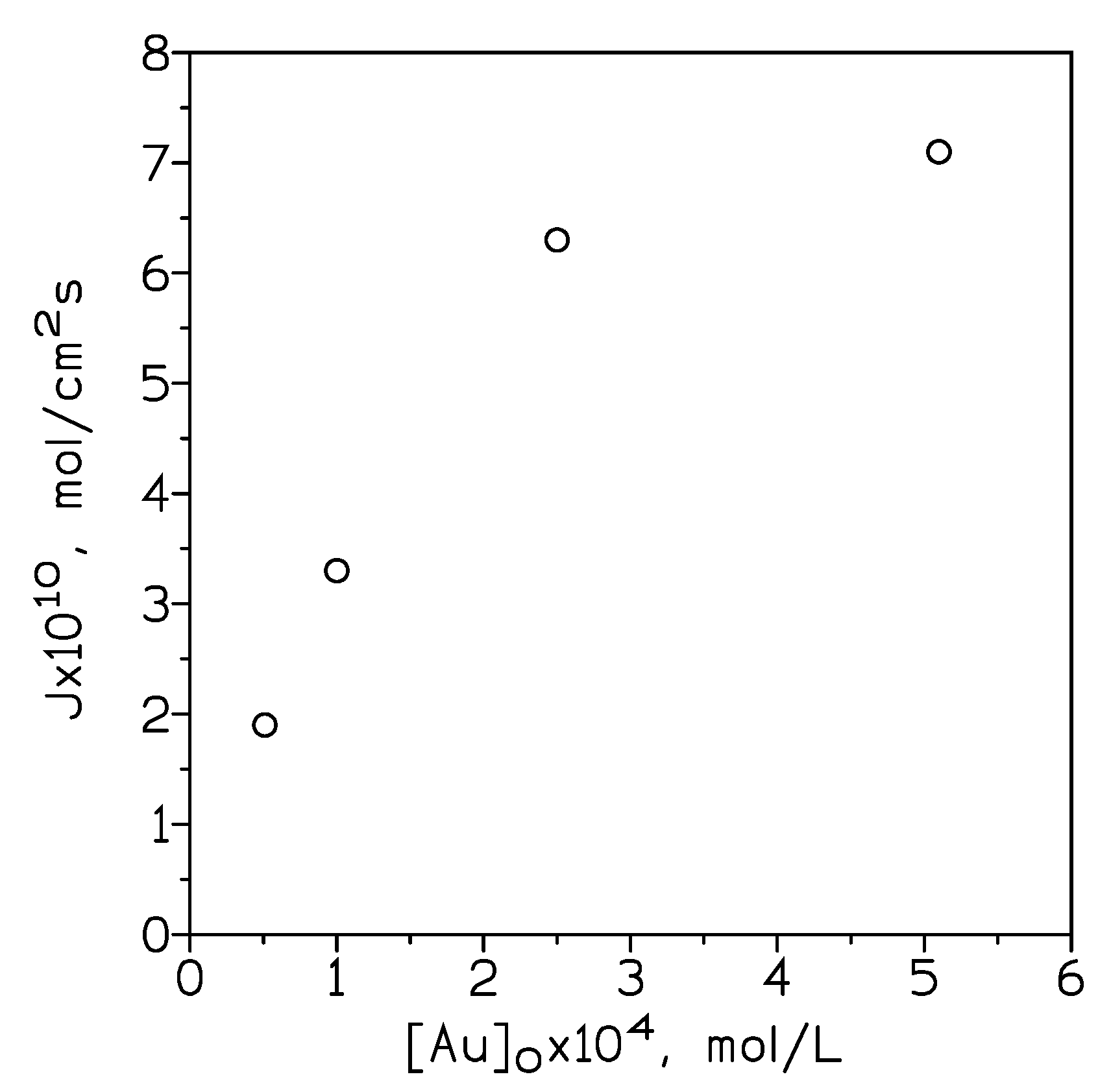
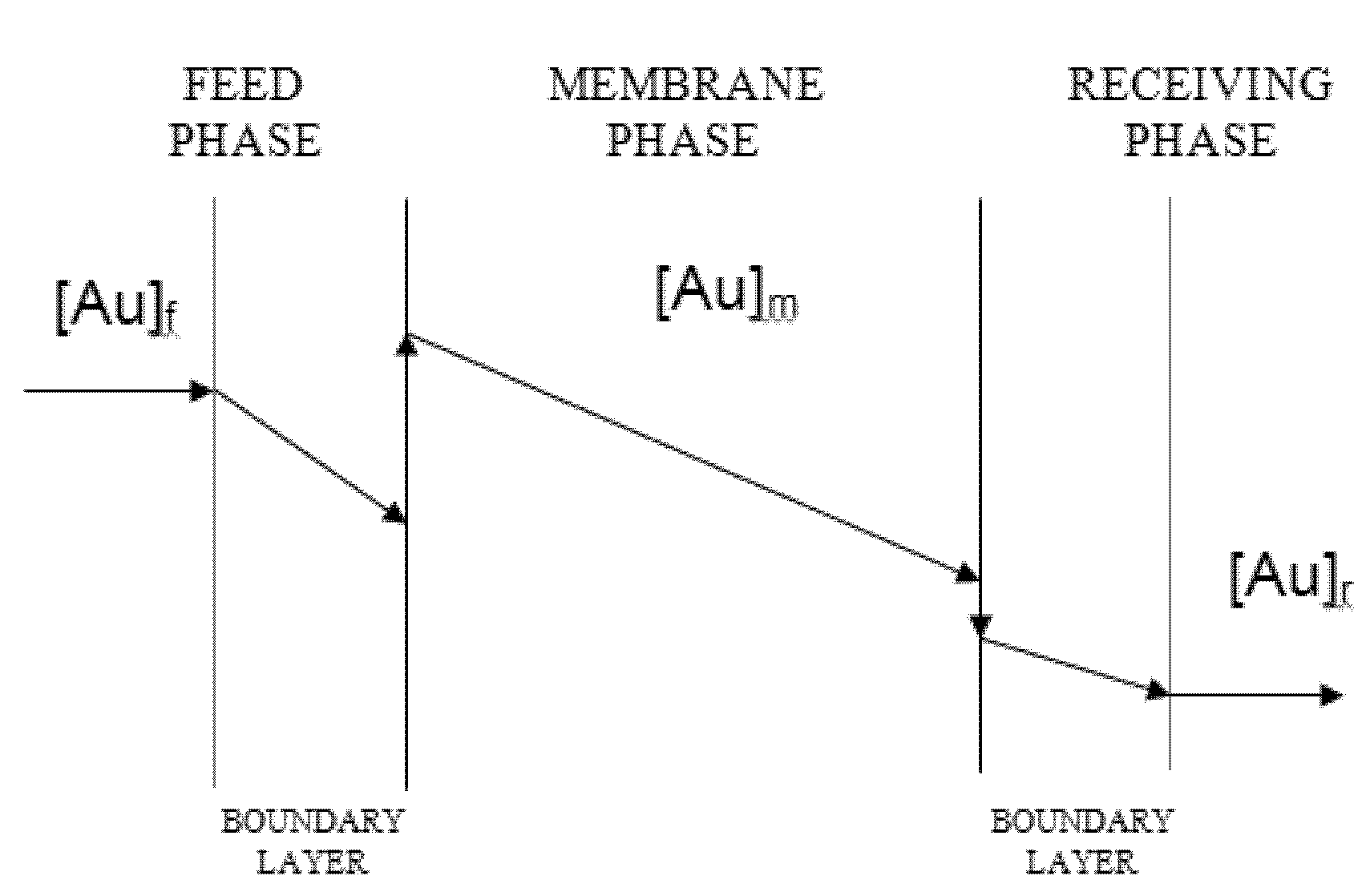

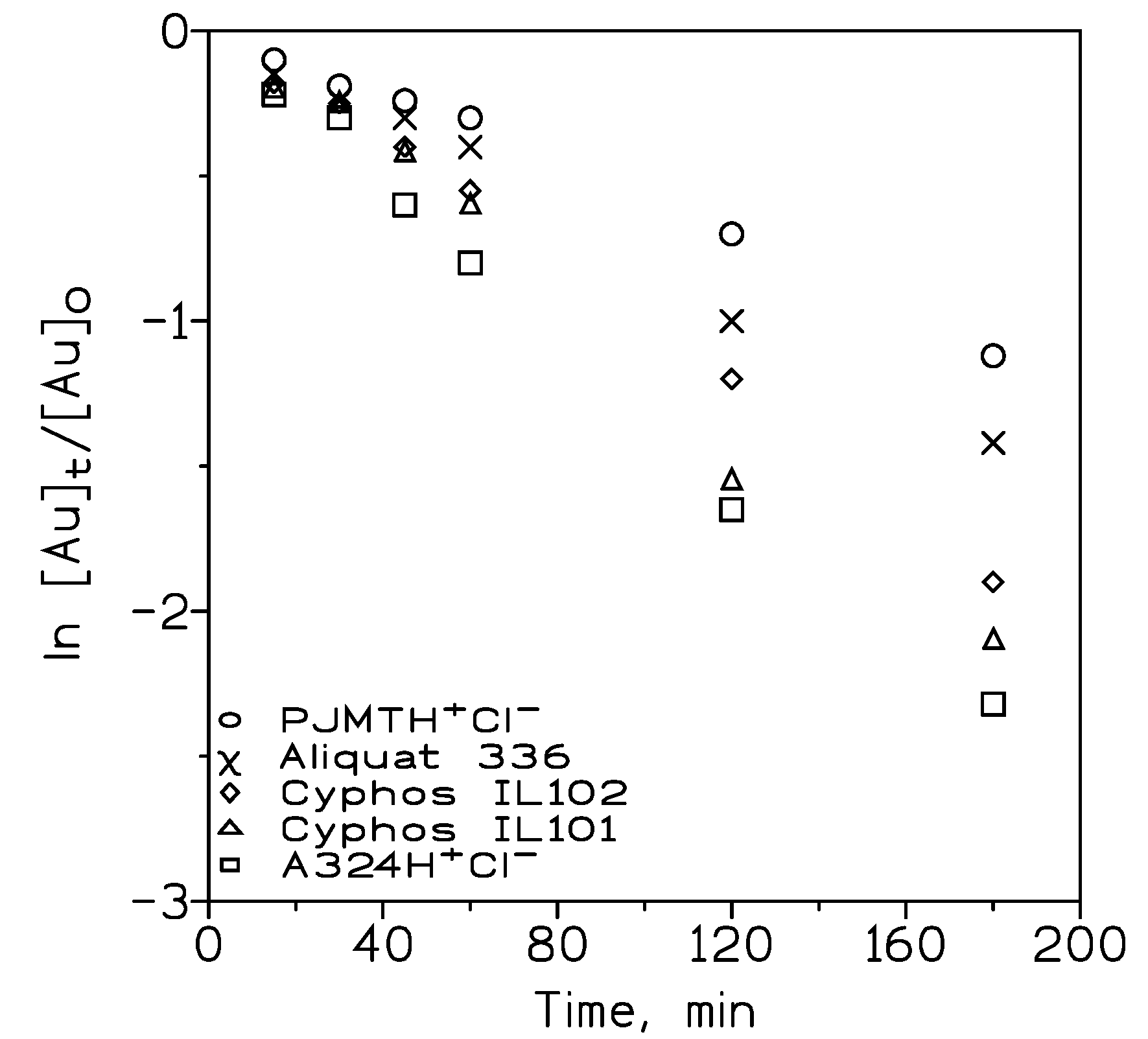
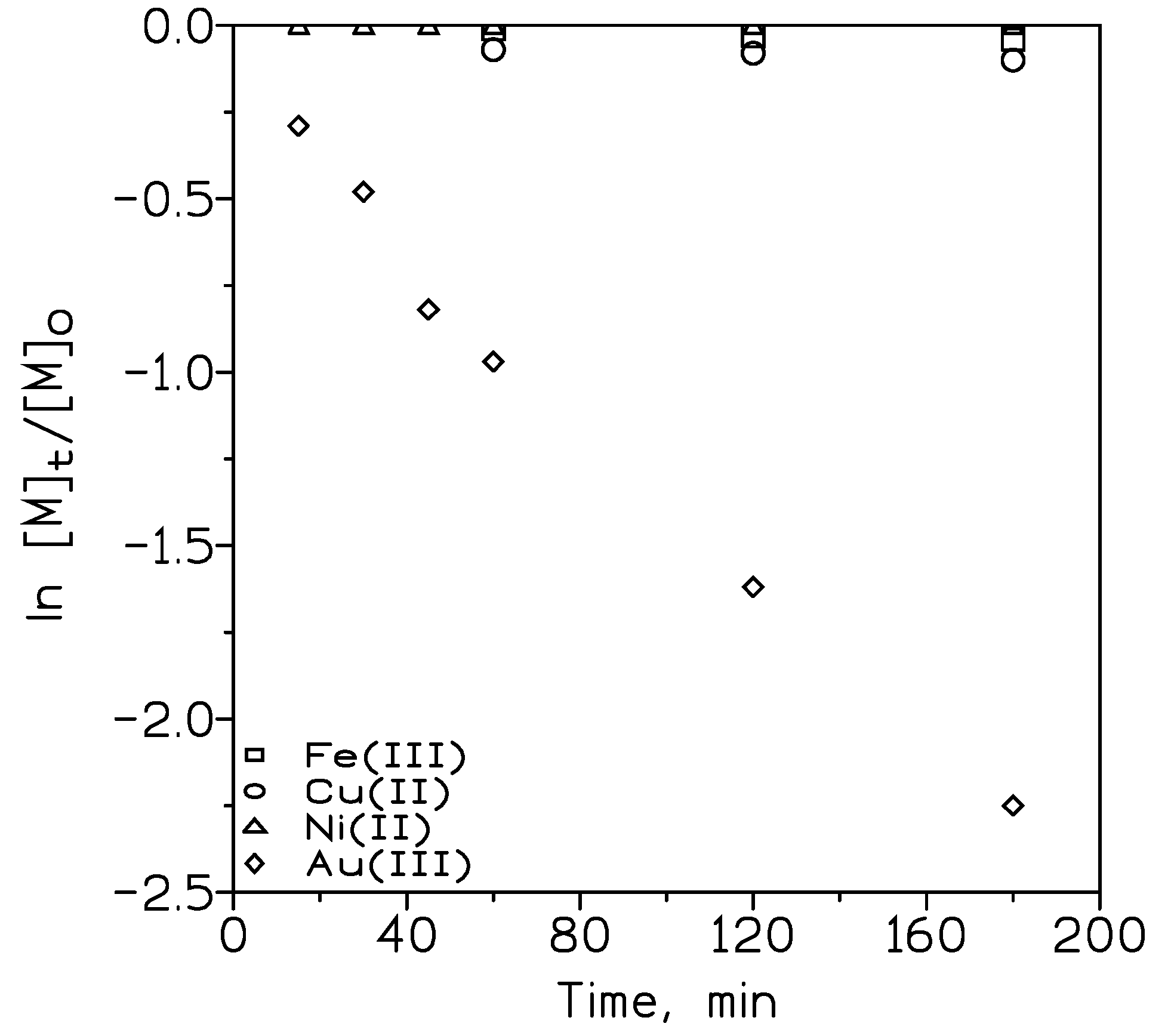
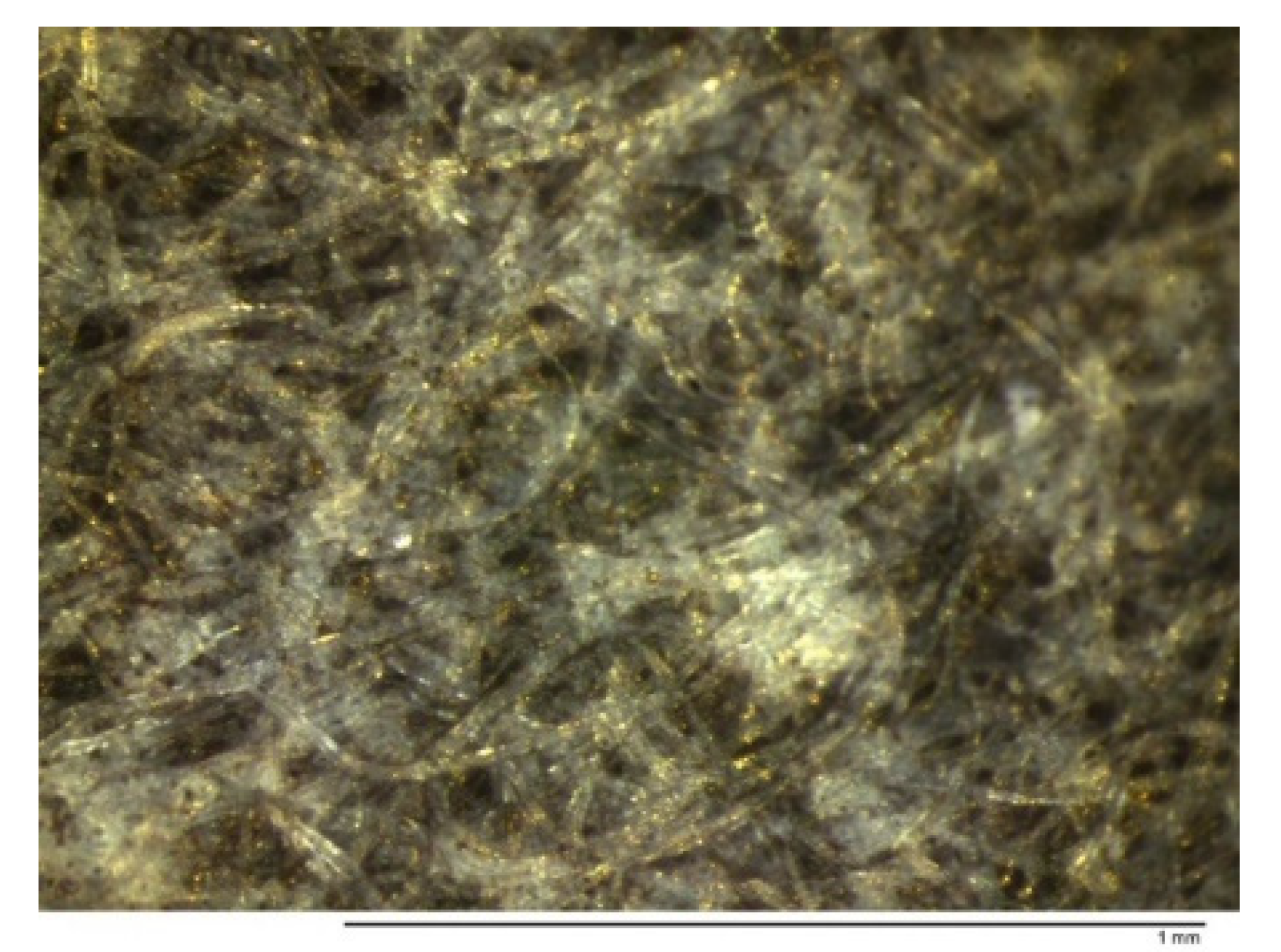
| [A324H+Cl−] (M) | aDAu |
|---|---|
| 0.012 0.0058 0.0023 0.0012 | 21.2 7.3 2.1 1.4 |
| Stirring Speed (rpm) | P × 103 (cm/s) |
|---|---|
| 375 425 500 750 1000 | 2.1 3.0 3.9 3.9 3.9 |
| HCl (M) | P × 103 (cm/s) |
|---|---|
| 0.5 1 2 4 6 | 2.8 3.9 2.6 2.2 1.8 |
| Carrier Concentration (M) | P × 103 (cm/s) |
|---|---|
| 0.023 0.058 0.12 0.23 0.17 0.46 0.92 | 1.8 2.6 3.2 3.8 3.9 3.4 2.9 |
| System | P × 103 (cm/s) |
|---|---|
| 1 M HCl 1 M LiCl 1 M NaCl | 3.9 2.3 2.5 |
| Name and Acronym | Active Group |
|---|---|
| Cyphos IL101 Cyphos IL 102 Aliquat 336 Primene JMT, PJMTH+Cl− | quaternary phosphonium chloride salt a quaternary phosphonium bromide salt a quaternary ammonium chloride salt b quaternary ammonium chloride salt c |
| Feed Phase | βAu/M |
| Au(III)-Cu(II) Au(III)-Fe(III) Au(III)-Ni(II) Au(III)-Cu(II)-Fe(III)-Ni(II) | 19 31 nickel was not transported 23 (Cu(II)), 57 (Fe(III)), no transport of Ni(II) |
© 2020 by the authors. Licensee MDPI, Basel, Switzerland. This article is an open access article distributed under the terms and conditions of the Creative Commons Attribution (CC BY) license (http://creativecommons.org/licenses/by/4.0/).
Share and Cite
Alguacil, F.J.; López, F.A. Permeation of AuCl4− Across a Liquid Membrane Impregnated with A324H+Cl− Ionic Liquid. Metals 2020, 10, 363. https://doi.org/10.3390/met10030363
Alguacil FJ, López FA. Permeation of AuCl4− Across a Liquid Membrane Impregnated with A324H+Cl− Ionic Liquid. Metals. 2020; 10(3):363. https://doi.org/10.3390/met10030363
Chicago/Turabian StyleAlguacil, Francisco José, and Félix A. López. 2020. "Permeation of AuCl4− Across a Liquid Membrane Impregnated with A324H+Cl− Ionic Liquid" Metals 10, no. 3: 363. https://doi.org/10.3390/met10030363
APA StyleAlguacil, F. J., & López, F. A. (2020). Permeation of AuCl4− Across a Liquid Membrane Impregnated with A324H+Cl− Ionic Liquid. Metals, 10(3), 363. https://doi.org/10.3390/met10030363






